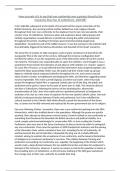Carmen
How accurate is it to say that non-conformity was a greater threat to the
monarchy than fear of Catholicism, 1660-88?
From 1660-88, subsequent to the death of Cromwell and the urgent restoration of the
British Monarchy, the new king and his brother battled two main religious threats
throughout their rule: non-conformity to the Anglican Church, but most prevalently, their
country’s fear of Catholicism. Numerous plots and suspicions about radical groups and
Catholic organisations caused distress to proliferate among the public and parliament,
throughout the period, resulting in the king’s government becoming dangerously
disobedient. Towards the end of the 1680s however, it was the aversion to the Catholic faith
that ultimately triggered the Glorious Revolution and downfall of the Stuart monarchy.
The Great Fire of London of 1666 resurged a scale of panic reminiscent of that left by the
Gunpowder Plot at the start of the century. Although the immense conflagration itself
terrified the nation, it was the suspected cause of the destruction which drove the country
into hysteria. The blame was unquestionably set upon the Catholics, some thought it was a
punishment from God for the toleration of and alliance with Catholics (i.e. Charles’ support
for Louis XlV of France), or it was believed that they themselves had conspired together and
started the blaze purposefully. Either way, the public had their minds made up; groups
began to violently attack suspected Catholics throughout the city, and rumours spread
about Charles’ brother surreptitiously worshipping the faith, and therefore suggesting James
may be responsible. This event scarred England, as twelve years later, when Titus Oats
spread his imaginary Popish Plot: a supposed Catholic plan to kill the king, the public and
parliament were quick to return to the state of alarm seen in 1666. The immense distrust
and fear of Catholicism, following the horrors of the desolating fire, allowed the
transformation of Oats’ story into reality and led a panicked parliament to instigate the
exclusion crisis, due to a new wave of suspicion for the now openly Catholic James. Not only
did this create great tension between Charles and parliament, but it also solidified the
cultural aversion to the Catholic faith which directly caused the descension of the Stuart
line, as James was forcibly removed and replaced by his own government due to his religion.
One year following Charles’ coronation, there was a non-conformist uprising from the Fifth
Monarchists, which also instilled alarm in the population. Although the group was quickly
quashed, their attempt to take power revived society’s fearful outlook on non-conformity as
something that threatened to dissemble the British structure and political stability. As a
result, people voted overwhelmingly for conservative MPs, in turn creating the Cavalier
Parliament, who soon met at the Savoy Conference to discuss tactics by which to extinguish
any non-conformists. Thus came the ejection of 1000 Presbyterian ministers and the passing
of the Clarendon Code, which consisted of four acts, including the Act of Uniformity, all
working towards the end of toleration. Meanwhile the king was of a wholly different
mindset, aiming to maintain the acceptance of non-conformity, and he issued a Declaration
of Indulgence to counteract parliament’s new laws. This collision between the king and
parliament surrounding non-conformity was, arguably, the beginning of the friction which
would create a large division between the two political branches and allow for parliament’s
betrayal of the monarchy. However, it was by no means as vital to the expulsion of James as
the prevailing terror of Catholicism, as this immense loathing of the faith gave parliament
the courage and, in their eyes, authority to exclude their king.




